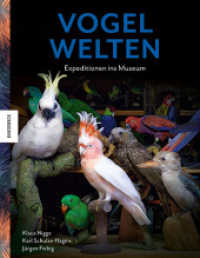- ホーム
- > 洋書
- > 英文書
- > Nature / Ecology
Full Description
Soil and Fertilizers: Managing the Environmental Footprint presents strategies to improve soil health by reducing the rate of fertilizer input while maintaining high agronomic yields.
It is estimated that fertilizer use supported nearly half of global births in 2008. In a context of potential food insecurity exacerbated by population growth and climate change, the importance of fertilizers in sustaining the agronomic production is clear. However, excessive use of chemical fertilizers poses serious risks both to the environment and to human health.
Highlighting a tenfold increase in global fertilizer consumption between 2002 and 2016, the book explains the effects on the quality of soil, water, air and biota from overuse of chemical fertilizers. Written by an interdisciplinary author team, this book presents methods for enhancing the efficiency of fertilizer use and outlines agricultural practices that can reduce the environmental footprint.
Features:
Includes a thorough literature review on the agronomic and environmental impact of fertilizer, from degradation of ecosystems to the eutrophication of drinking water
Devotes specific chapters to enhancing the use efficiency and effectiveness of the fertilizers through improved formulations, time and mode of application, and the use of precision farming technology
Reveals geographic variation in fertilizer consumption volume by presenting case studies for specific countries and regions, including India and Africa
Discusses the pros and cons of organic vs. chemical fertilizers, innovative technologies including nuclear energy, and the U.N.'s Sustainable Development Goals
Part of the Advances in Soil Sciences series, this solutions-focused volume will appeal to soil scientists, environmental scientists and agricultural engineers.
Contents
Effects of Fertilizers on Soil Quality and Functionality.Treatment of Wet Organic Waste by Hydrothermal Carbonization. Crop Residue Management for Improving Soil Carbon Storage, Nutrient Availability and Fertilizer Use Efficiency. Improving Soil Fertility through Fertilizer Management in Sub-Saharan Africa. The Storage of Organic Carbon in Dryland Soils of Africa: constraints and opportunities. Manures Vs Fertilizers in Rainfed Dryland Production Systems of India. Reducing emission of greenhouse gases from fertilizer use in India. Soil Health and Fertilizer Use in India. Isotopes Applications in Fertilizer Research. Managing fertilizers in soils of paddy rice. Nuclear Powered Agriculture: Fertilizers and Amendments. Nitrogen Dynamics and Management in Rainfed Drylands: issues and challenges. Tailored Fertilizers The Need of the Times. Managing Soils for Reducing the Dependence on Chemicals and Import of Resources into Agro-Ecosystems








